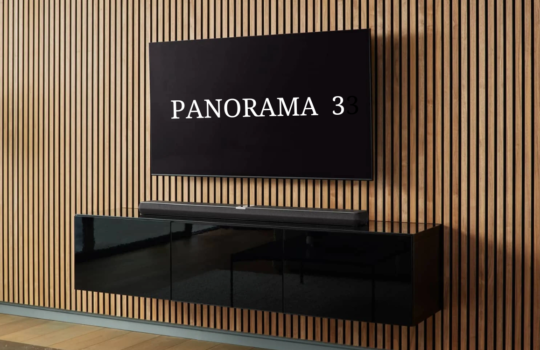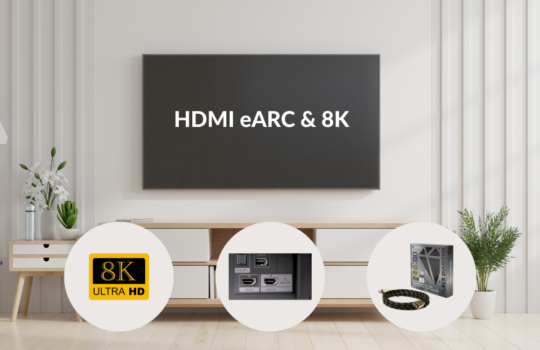Home theatres come in a variety of formats; some require large rooms while others are suited for smaller ones. By establishing the exact location of your home theatre, you can decide what kind of system you should go for. Also, consider whether the room will be used for personal viewing or large gatherings. The latter may require you to carefully plan your layout, keeping viewing angles, viewing distance and other factors in mind.
Components of a home theatre system
1. A/V receiver
An A/V (audio/video) receiver serves as the heart of your home theatre system; processing, amplifying and transmitting sound to your speakers. All receivers have a built-in sound system decoder that converts all sound inputs into surround sound.
Considerations
- Make sure your receiver has enough outlets to cover all your cables and devices, including coaxial and optical cables for audio sources, S-video and component video cables for video playback, and HDMI cables for audio-video toggling.
- A high-wattage receiver delivers better sound quality than a low-wattage one, even at low and medium volumes.
Tip: Networked and smart receivers can eliminate the need for remote controls altogether, giving you direct control over your home theatre on your mobile device.
2. Television
A big-screen television can act as the focal point of your home theatre system, channelling a projector-like view while giving you access to the latest television technologies.
Considerations
- Guard your television against obsolescence by investing in future-fit features like Organic Light-Emitting Diode (OLED – allows for better power efficiency, physical flexibility, sharper contrasts and faster refresh rates than LED), Quantum Dot LED (QD-LED – offers a wider colour range than OLEDs) and High Dynamic Range (HDR – facilitates more natural- and real-looking content).
- Curved televisions, by delivering a panoramic display, can make for the ultimate immersive television viewing experience.
Note: Full HD televisions require the distance between you and the TV to be about three times the height of the screen (measured up to the top), whereas 4K televisions only require a viewing distance of around one-and-a-half times the height of the screen. The latter is better suited for smaller rooms.
3. Projector and screen
If you dream of creating a grand cinematic escape inside your home, a projector and screen (as an alternative to a television) are your best bets.
Considerations
- When it comes to projectors, look for models with a brightness above 1500 lumens.
- Determine your projector type based on the distance from the screen or wall. Short throw projectors can be gold for a small home theatre, allowing for a setup less than a metre away from the screen.
Tip: To calculate your ideal screen height, divide the distance of the furthest possible viewing point by five. For example, if your room is 15 metres long, your screen needs to be about 3 metres high.
4. Speakers and subwoofers
While speakers are pointed at producing a range of frequencies, subwoofers provide the ‘bass effect’ through low-frequency sound. If you’re an audiophile, you know that the audio quality can make or break your movie-watching experience. Take your time choosing a speaker system that reflects your requirements, budget and room size.
Considerations
- Sound quality, depth and clarity are directly proportional to the number of speakers. However, the greater the number of speakers (more on this later), the more space you need.
- Establish a trade-off between your desired sound quality and the size of your room.
5. Media player and recorder
Media players, such as Blu-Ray and DVD players, can be paired with compatible televisions to unlock a world of online and disc-based content.
Considerations
- Ultra HD, 3D-capable and smart players offer a plethora of future-fit functions and features across various content formats.
- If the majority of your viewable content is on DTH, choose a system with an built-in personal video recorder to watch what you want when you want.
- If you own a large digital movie archive, install a network-assisted storage drive to share it across all your compatible devices and home theatre equipment.
Channel architecture
Home theatres come in various styles, designs and channel architectures, from basic 2.0 stereo setups (2 speakers + no subwoofer) to swish 11.1 surround sound systems (11 speakers + 1 subwoofer). There’s no holy grail to determine the ideal number of speakers for a room size, but a 5.1 system (5 speakers + 1 subwoofer) is considered the de facto choice for a wraparound sound experience in most medium-sized home theatre environments. If you have a larger room, a 7.1-channel or larger system may be for you.
Type of speakers
Speakers come in an assortment of shapes and sizes, giving you the option of mixing and matching models across your room.
- Bookshelf speakers: Ideal as additions to bookshelves, these speakers are compact, and suited for handling mid-range and high-end frequencies. They can also be wall-mounted.
- Floor-standing speakers: These can handle a range of frequencies, and are available in various sizes.
- In-wall and in-ceiling speakers: These speakers are embedded into the wall or ceiling, channelling a sleek and pared-back look.
Tip: It’s a good idea to install speaker cables along your walls to save them from entangling and becoming a safety hazard.
Home theatre requirements vary as per budget, room size and other considerations. While you may have space to accommodate floor speakers at the front of your room, you may not be able to accommodate rear speakers, and may prefer to install in-wall or in-ceiling speakers as a compact alternative. Going the à la carte route allows you to pick individual, compatible pieces that combine to give you the best in audio and aesthetics.
For optimum sound delivery, make sure your front speakers are positioned at an equal distance from the screen, at ear height, and your surround speakers are positioned about 110-120 degrees behind the listening position, at 1 to 2 feet above head level. Your central speaker should also be mounted at ear height.
Budget
Home theatres in India run a gamut of prices, with basic 2.1-channel models starting as low as ₹1500, and more high-end, sophisticated systems featuring six-figure price tags. With brands and designs to fit every budget, it’s up to you to draw the distinction between must-have and nice-to-have features.
While a big screen can conjure lifelike cinematic vibes, it’s important to pay attention to the possible viewing angles. The best viewing angle is about 30 to 40 degrees, at a distance twice the diagonal width of the screen. The centre of the screen should ideally be at eye level.
Brand
When it comes to home theatre systems, you’ll find dozens of budget options. However, if you’re looking for quality, durability and customer service, consider stretching your budget and investing in a trusted brand that will last you in the long run. Some tried-and-true brands to consider are Philips, Sony, Logitech, Mitashi and Samsung.
Compatibility
It’s important to check the compatibility of your home theatre components with your existing equipment before locking in your purchase. Also, ensure that your television or projector features one extra HDMI port to accommodate future wiring requirements.
Upscaling
In an age that’s all about high-definition, it makes sense to invest in an A/V receiver that can upscale non-HD videos to HDMI. Other features to consider include de-interlacing (augmenting interlaced video such as analogue television signals to a digital format), and scaling (enhancing a video’s resolution without changing the format).
Most amplifiers in the market today support basic surround sound technologies such a Dolby Digital, Dolby Pro Logic IIx and DTS. However, investing in advanced HD audio formats like Dolby TrueHD, Dolby Digital Plus and DTS HD can enhance your surround sound experience. As uncompressed technologies, these provide a home audio experience akin to an original recording. If you’re willing to go premium, THX is a worthwhile option to consider. It is a top-of-the-line acoustic standard that can deliver unmatched sound qualit






















A home theatre refers to a combination of home entertainment systems that seek to recreate the experience of a movie theatre with the help of special audiovisual equipment including an A/V receiver, a screen, speakers, a subwoofer and a multimedia system. Installing a home theatre can be as basic as connecting a stereo system to an existing television setup or as complex as combining a projector, screen, multimedia player and multichannel surround sound setup to mirror a movie theatre environment.